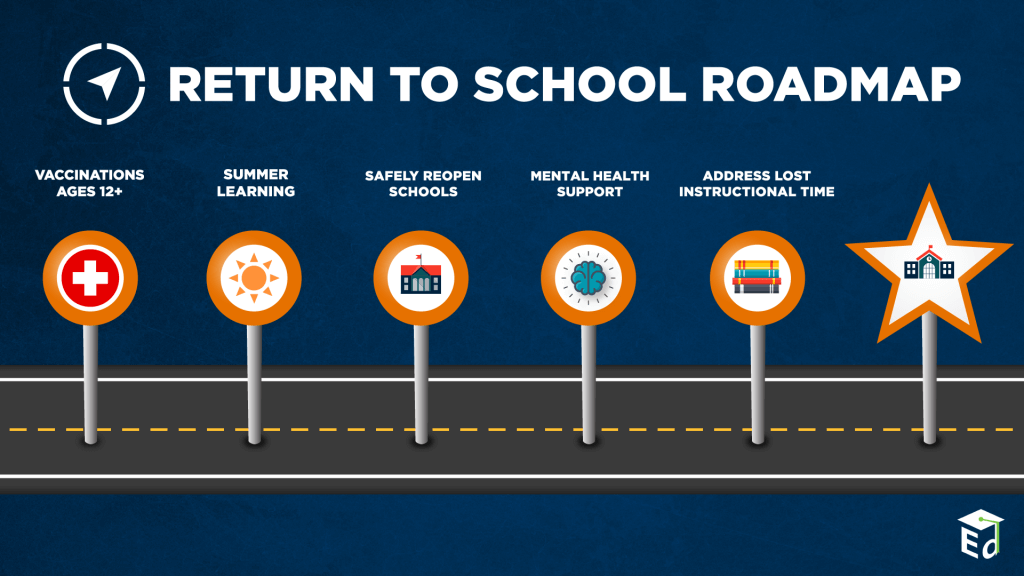Prioritizing Student Mental Health: Holistic Approaches to Supporting Student Wellbeing
Last month, the U.S. Department of Education launched a Return to School Roadmap and a corresponding report that outlines strategies for addressing the impact of lost instructional time. In line with one of the Roadmap’s priorities to “build school communities and support students’ social, emotional, and mental health,” the report provides recommendations for engaging with students, parents, and caregivers, with a focus on social, emotional, and mental health needs. This emphasis is timely—the majority of students have experienced mental or emotional challenges during the pandemic, and experts agree that supporting mental health is imperative as schools reopen and classes resume.

But what does effectively supporting student wellbeing look like for states, districts, and schools? The ecosystem of supports, interventions, and tools can be complex for educators, families, and students to navigate. What’s more, funding streams don’t always align to help SEAs and LEAs meet the highest needs.
Below, we outline the key components of a holistic approach to supporting student social, emotional, and mental health— (1) prevention, (2) identification & referral, (3) treatment, and (4) workforce development—and how solutions within these categories work together to support school communities.
Prevention
Safeguarding student mental health starts long before challenges emerge and crises unfold. Investing in upstream initiatives like school climate and bullying prevention programs, social-emotional learning for students and staff, and the adoption of trauma-informed practices by educators and staff can help to foster safe and supportive environments where students thrive. Programs aligned to CASEL’s newly revised SEL framework—for example, Kognito’s library of simulations for PK-12 educators, secondary school students and community members—enhance protective factors, such as supportive relationships and self-awareness.
Identification & Referral
Together with preventive efforts, it is important to have an effective system for identifying students in need of additional support and helping them access the services they need. Traditional face-to-face screenings might be conducted annually by clinicians, but this approach provides only a snapshot in time of a student’s wellbeing. More recently, significant efforts have been made to apply technology to the process of identification. Tools like school climate and wellbeing surveys from Panorama Education and automated document and social media screening from Gaggle and others fall into this category. But technology can also be applied to ensure that teachers and school staff members are effective eyes and ears of mental health. Kognito’s flagship suite of online professional development programs empower those who are on the frontlines with students everyday—both virtually or in-person—through hands-on practice to observe, intervene, and make timely referrals.
Treatment
Once students are referred to receive additional support, trained professionals like psychologists, social workers, and counselors provide school-based mental health programs and services. These services can take place individually or in group settings and are increasingly being provided via telemedicine to combat clinician shortages and other barriers to accessing high-quality care. Depending on needs, districts may partner with community organizations and agencies like county mental health providers or education service agencies to effectively deliver treatment. Organizations like CareSolace—which helps students, families, and school staff to find the right trained therapist—or PresenceLearning—which provides mental and behavioral therapy for students via telemedicine—are helping to address issues of access to high-quality care.
Workforce Development
Underlying each of the above categories is the need for high-quality professionals both inside and outside of the classroom. It is hard to implement preventive measures without well-trained staff and teachers. Likewise, knowing when to refer a student to additional services is only helpful if there are school psychologists, social workers, and counselors at the ready to provide the needed support. Shortages in school mental health professionals are not new, but the pandemic has elicited a renewed sense of urgency to address the pipeline and workforce development in the field.
Each of the above categories of support for student mental health must be a priority as school communities continue to navigate teaching and learning during the ongoing pandemic,. They are all indispensable parts of an ecosystem that is necessary for students to thrive inside and outside of the classroom. As states, districts, and schools consider how to invest in student mental health supports moving forward, it is critical to keep in mind how solutions within each of the categories work together to support students, teachers, and staff.
Explore Simulation-Based Solutions for PK-12 Students and Educators
Kognito’s research-proven and evidence-based simulations use role-play conversations with virtual humans to help build the capacity of students, staff, and the greater school community. If you’d like to learn more about the simulations and how they can help support students through meaningful conversations surrounding mental health, visit Kognito.com, or better yet, experience a simulation through an interactive demo.